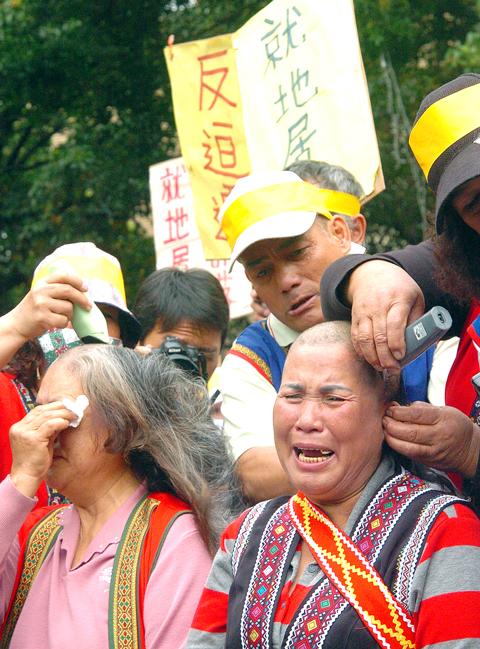Amis Aborigines from the Kanjin (崁津) and Saowac communities in Taoyuan County that are facing demolition rallied outside the Executive Yuan yesterday, calling on the central government to intervene.
The two communities are located on the banks of the Dahan River (大漢溪) in Dasi Township (大溪), Taoyuan County. The Kanjin Community got its name from the nearby Kanjin Bridge (崁津大橋), while Saowac is the Amis word for “riverside,” said Chang Chin-tsai (張進財), a preacher at the Saowac Church.
“Saowac has been there for 28 years,” Chang said. “The residents are Amis from Hualien and Taitung counties who migrated to Taipei and Taoyuan to find work, but could not afford housing.”

PHOTO: GEORGE TSORNG, TAIPEI TIMES
He said that the community has about 40 residents.
The 80 residents at the Kanjin Community share a similar background.
“I came here more than 20 years ago from Chengkung Township [成?Taitung County, because I could not find a job in my hometown,” said Azun Balis, a Kanjin resident. “After I got here, I found a construction job.”
In her sixties now, Azun still works part-time jobs on construction sites.
“With this recession, jobs are hard to find and if they tear down my house, I really don’t know how I can carry on living,” she said.
The demolition notices, issued by the Taoyuan County Government, came in May for Kanjin and December for Saowac, to make way for a riverside park and bike path. The county government said in the notice that the plan would also protect the Aborigines from the threat of flooding.
But Kanjin and Saowac residents resisted the eviction order, saying that in the decades they have lived there the areas have never flooded.
“No to forced eviction! We want to stay where we are!” nearly 100 residents from the two Taoyuan communities and their supporters shouted as they demonstrated.
Fifty of the demonstrators shaved their heads.
“They shaved their heads to show their determination to save their homes because they don’t want to see bloodshed, but if the government doesn’t respond to them, we Aborigines will certainly take more extreme action,” said Panay Luni, an Amis who came from Taitung to support her people.
“Most of these people are in their fifties and sixties. They have nowhere else to go. Why can’t they just be left alone?” Panay said.
Council of Indigenous Peoples Vice Minister Wang Chin-fa (王進發), who came out to meet the demonstrators, only promised he would help negotiate with the Taoyuan County Government.
“It would be a little hard to allow you to stay where you are since it’s illegal to live in a flood zone and all public servants must abide by the law. I’ll talk with the county government to see if we can come up with a better resolution,” Wang said, before being booed and interrupted by upset demonstrators, after which he hurriedly left.
“Our muddle-headed government only cares about achievements that people can see, they don’t care about people’s lives,” said Lin Chih-chiang (林志強), a Dasi Township councilor of Amis origin. “Politicians always say that they care about Aborigines and stand with us, but when they’re elected and we’re in trouble, they are nowhere to be found.”

Chinese Nationalist Party (KMT) Chairman Eric Chu (朱立倫), spokeswoman Yang Chih-yu (楊智伃) and Legislator Hsieh Lung-chieh (謝龍介) would be summoned by police for questioning for leading an illegal assembly on Thursday evening last week, Minister of the Interior Liu Shyh-fang (劉世芳) said today. The three KMT officials led an assembly outside the Taipei City Prosecutors’ Office, a restricted area where public assembly is not allowed, protesting the questioning of several KMT staff and searches of KMT headquarters and offices in a recall petition forgery case. Chu, Yang and Hsieh are all suspected of contravening the Assembly and Parade Act (集會遊行法) by holding

PRAISE: Japanese visitor Takashi Kubota said the Taiwanese temple architecture images showcased in the AI Art Gallery were the most impressive displays he saw Taiwan does not have an official pavilion at the World Expo in Osaka, Japan, because of its diplomatic predicament, but the government-backed Tech World pavilion is drawing interest with its unique recreations of works by Taiwanese artists. The pavilion features an artificial intelligence (AI)-based art gallery showcasing works of famous Taiwanese artists from the Japanese colonial period using innovative technologies. Among its main simulated displays are Eastern gouache paintings by Chen Chin (陳進), Lin Yu-shan (林玉山) and Kuo Hsueh-hu (郭雪湖), who were the three young Taiwanese painters selected for the East Asian Painting exhibition in 1927. Gouache is a water-based

Taiwan would welcome the return of Honduras as a diplomatic ally if its next president decides to make such a move, Minister of Foreign Affairs Lin Chia-lung (林佳龍) said yesterday. “Of course, we would welcome Honduras if they want to restore diplomatic ties with Taiwan after their elections,” Lin said at a meeting of the legislature’s Foreign Affairs and National Defense Committee, when asked to comment on statements made by two of the three Honduran presidential candidates during the presidential campaign in the Central American country. Taiwan is paying close attention to the region as a whole in the wake of a

OFF-TARGET: More than 30,000 participants were expected to take part in the Games next month, but only 6,550 foreign and 19,400 Taiwanese athletes have registered Taipei city councilors yesterday blasted the organizers of next month’s World Masters Games over sudden timetable and venue changes, which they said have caused thousands of participants to back out of the international sporting event, among other organizational issues. They also cited visa delays and political interference by China as reasons many foreign athletes are requesting refunds for the event, to be held from May 17 to 30. Jointly organized by the Taipei and New Taipei City governments, the games have been rocked by numerous controversies since preparations began in 2020. Taipei City Councilor Lin Yen-feng (林延鳳) said yesterday that new measures by